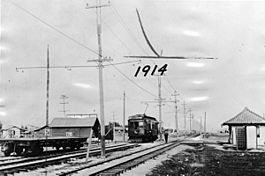Hawthorne–El Segundo Line facts for kids
Quick facts for kids Hawthorne–El Segundo |
|
|---|---|

El Segundo, 1914
|
|
| Overview | |
| Owner | Southern Pacific Railroad |
| Locale | Los Angeles, and the South Bay |
| Termini | Downtown Los Angeles El Segundo, California |
| Stations | 22 |
| Service | |
| Type | Interurban |
| System | Pacific Electric |
| Operator(s) | Pacific Electric |
| Rolling stock | PE 1000 Class (last used) |
| Ridership | 304,996 (1926) |
| History | |
| Opened | August 10, 1914 |
| Closed | October 31, 1930 |
| Technical | |
| Line length | 18.87 miles (30.37 km) |
| Track gauge | 1,435 mm (4 ft 8 1⁄2 in) standard gauge |
| Electrification | 600 V DC Overhead lines |
The Hawthorne–El Segundo Line was a special train route run by the Pacific Electric Railway. It was built to carry oil from the Standard Oil Refinery in El Segundo. But it also carried people! This train line helped connect different parts of Los Angeles and the nearby South Bay area.
Contents
History of the Hawthorne–El Segundo Line
Why Was the Line Built?
El Segundo started as a "company town" for Standard Oil. This means the town was built mainly for the company's workers. In 1911, Standard Oil announced where their big oil refinery would be. The Pacific Electric company quickly started planning a new train line to reach it.
Building the Railway
Construction of the train line began in 1913. The very first trains arrived in downtown El Segundo on August 10, 1914. At first, you could travel directly from El Segundo to Los Angeles between 1920 and 1924. However, the line mostly worked as a shuttle. This meant passengers would take one train to Hawthorne and then switch to another train to reach Los Angeles.
End of Passenger Service
Not many people used the train for travel. Because of this, passenger service stopped after Halloween in 1930. But the line was still very important for carrying goods, especially oil. This freight service continued to make a lot of money for Pacific Electric.
Even though passenger trains stopped, freight trains kept running. By 1981, the tracks in downtown El Segundo were removed. However, steam and diesel trains continued to use the line from Watts all the way to the Standard Oil Refinery (which later became Chevron). Today, the line is owned by Union Pacific.
What Was the Route Like?
The Hawthorne–El Segundo Line carried both people and goods between Los Angeles, Watts, and El Segundo. It also helped connect other train lines, like the San Pedro via Gardena Line and the Redondo Beach via Gardena Line, to Watts and Los Angeles. You could also switch to Los Angeles Railway lines to go to other parts of Los Angeles.
How the Tracks Were Laid Out
The entire train line was on its own private land. This means it didn't share space with roads or other traffic. The part of the line between Watts Junction and South Los Angeles had two tracks. This allowed trains to go in both directions at the same time. The rest of the line to El Segundo had only one track.
Key Stops Along the Way
The line started at Watts Junction. From there, it went west with two tracks to South Los Angeles. At this point, the Redondo Beach via Gardena Line and the San Pedro via Gardena Line branched off.
The single-track Hawthorne–El Segundo Line continued west. It passed under Western Avenue and then turned southwest towards Crenshaw Boulevard. After that, it turned west again, running parallel to El Segundo Boulevard. It crossed Hawthorne Boulevard, where you could connect to the Hawthorne–El Nido Line or switch to the Los Angeles Railway.
The line then turned southwest and crossed El Segundo Boulevard again. It continued to a place called Wise, where it crossed another railway track. Here, trains could exchange goods between Pacific Electric and the Atchison, Topeka and Santa Fe Railway.
A special track called the "Standard Oil Spur" went from Wise right into the Standard Oil Refinery. This track helped move the oil directly from the refinery.
Finally, the line turned northwest, going through oil fields. It then turned west again and continued to its end at the El Segundo Station.
Major Stations on the Line
Here are some of the main stations along the Hawthorne–El Segundo Line:
| Station | Major connections | Date opened | Date closed | City |
|---|---|---|---|---|
| Pacific Electric Building | Many Pacific Electric lines and Los Angeles Railway lines | 1905 | 1961 | Los Angeles |
| Amoco | Many Pacific Electric lines | 1902 | 1961 | |
| Slauson Junction | Many Pacific Electric lines | 1902 | 1961 | |
| Watts | Many Pacific Electric lines | 1902 | 1961 | |
| Forest | Redondo Beach via Gardena, San Pedro via Gardena and Los Angeles Railway lines | 1911 | 1940 | |
| Delta | San Pedro via Gardena | 1911 | 1940 | |
| Hawthorne | Hawthorne–El Nido and Los Angeles Railway lines | 1914 | 1930 | Hawthorne |

